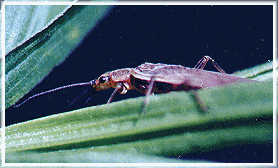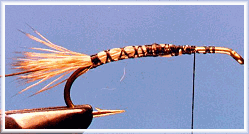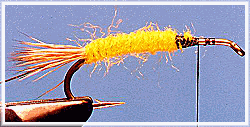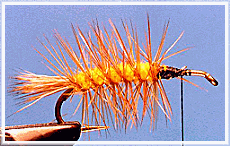 Stoneflies don't hatch on the surface of the water like mayflies and caddisflies do.
Instead, the nymphs crawl out of the water onto a rock, weed, twig or some other
solid object to emerge as an adult. That leaves a telltale hull everywhere a stonefly
hatches into an adult. Visible signs of a hatch.
Stoneflies don't hatch on the surface of the water like mayflies and caddisflies do.
Instead, the nymphs crawl out of the water onto a rock, weed, twig or some other
solid object to emerge as an adult. That leaves a telltale hull everywhere a stonefly
hatches into an adult. Visible signs of a hatch.
After hatching, stoneflies crawl around the local vegetation for a while. If you look
closely, you'll have a chance to observe the size and color of the flies before they
return to the water to lay their eggs.

If you're fast, you might even be able to capture a few samples to take home with
you in a bottle full of alcohol for future reference at the tying table.
Since stoneflies don't hatch on the water's surface, they are only available
to the fish as nymphs, and adults that are laying their eggs. That's where
the stimulator is important. It's a great pattern to imitate the egg laying
phase of a stonefly's life.
Like caddisflies, stoneflies skim the water's surface in riffles and rapids
when they lay their eggs. Their best imitations are flies that skitter over
fast water without becoming waterlogged or soggy. And, since stoneflies
come in several colors and sizes, it's wise to have a variety of stimulators
in your fly box for those special hatches.
In fast water, the stimulator can also be used to imitate hoppers and caddisflies
when tied in the right colors and sizes. If you use quality hackle, it floats high
in the surface tension, and if the current manages to pull it down, the hollow elk
hair will keep it afloat anyway. A versatile fly for a specific type of water. A
specific fly for fast water.
Enough about how and where to fish the fly, let's learn how to tie it.
List of materials:
 Hook: Curved shank; Tiemco 2302 (preferred), Tiemco 200R, Mustad 80050BR,
Eagle Claw L052, Daiichi 1270. Size 6-14.
Hook: Curved shank; Tiemco 2302 (preferred), Tiemco 200R, Mustad 80050BR,
Eagle Claw L052, Daiichi 1270. Size 6-14.

Thread: 6/0 Gudebrod or equivalent, black, red, yellow, or colored to match the body.
Tail: Elk hair.
Body - Anglers Choice Llama dubbing, Rainy's No-Dub, punch embroidery yarn,
floss and herl, any other dubbing that is designed for dry flies. Color to match the body
of the natural (usually yellow, tan, olive, black or orange).
Wing: Elk hair, tied to flare slightly.
Hackle: Brown, tan or cree saddle or neck hackle, wrapped "palmer
style" over the body and ribbed down with fine gold wire. Grizzly hackle
wrapped dry fly style near the head.
Rib: Fine gold wire.
|




 Stoneflies don't hatch on the surface of the water like mayflies and caddisflies do.
Instead, the nymphs crawl out of the water onto a rock, weed, twig or some other
solid object to emerge as an adult. That leaves a telltale hull everywhere a stonefly
hatches into an adult. Visible signs of a hatch.
Stoneflies don't hatch on the surface of the water like mayflies and caddisflies do.
Instead, the nymphs crawl out of the water onto a rock, weed, twig or some other
solid object to emerge as an adult. That leaves a telltale hull everywhere a stonefly
hatches into an adult. Visible signs of a hatch.









